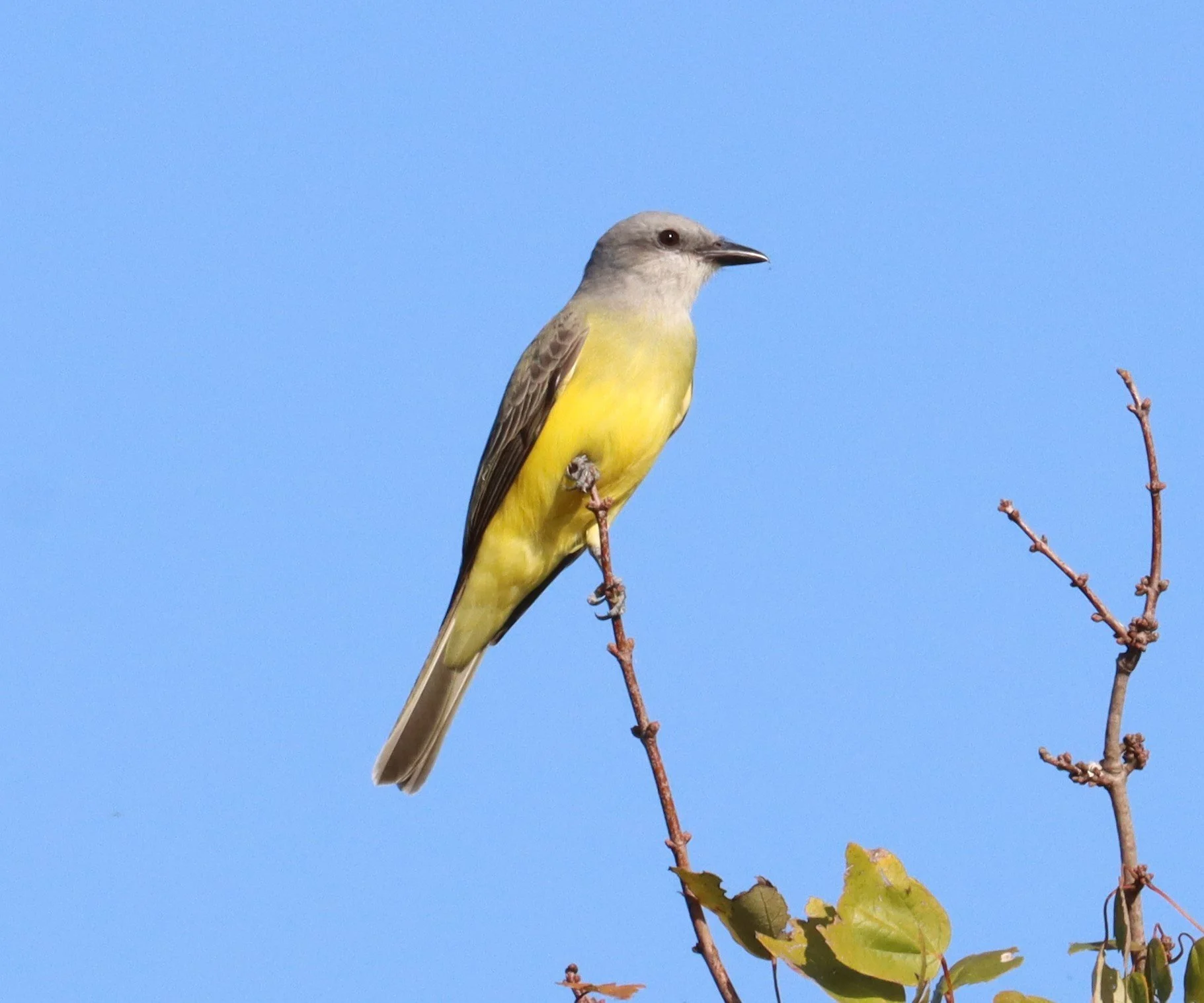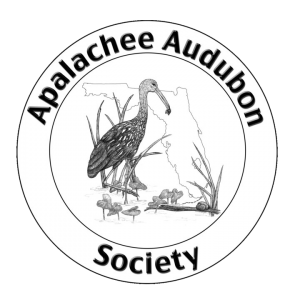On the afternoon of November 6th, 2023, my husband Jimmy and I headed to Lake Elberta Park to check out the mudflats and see what kind of shorebirds might be stopping in. Fresh off a lake clean up that we participated in with Apalachee Audubon Society, we knew the lake was in much better shape than usual as far as trash, and since we had not had rain in over a month the water levels were very low, exposing wonderful mudflats here. The lake was filled with many of the usual suspects, roughly 300 Black-bellied Whistling Ducks, 32 Double-crested Cormorants, a couple Wilson's Snipes, Great Egrets, a Wood Stork, a Great-blue Heron, and at that moment, most notably 30 Long-billed Dowitchers.
I shifted the focus of my binocs from the mudflats and glanced at the top of the tree next to me, landing on a brilliant yellow-bellied Kingbird! I quickly started snapping pictures and urged Jimmy to do the same. As I worked my way closer to the bird I glanced at the Purple Martin array, which was topped with a Gray Kingbird! This silvery bug-catching machine is typically found in coastal areas. In Leon County, where there is no coast, only one previous, completely undocumented, report has appeared on eBird.
Kingbird with a yellow belly, eventually identified as a Couch’s Kingbird. Photo by Juli deGrummond.
Watch a video of the Couch’s Kingbird at Lake Elberta Park.
As far as the yellow-bellied kingbird, in our area, the expected bird with this color scheme would be the Western Kingbird. But a Western Kingbird would have more gray in the bib area of the chest and would have white outer tail feathers. With the Western being eliminated as a possibility the next most likely bird would be a county first, the Tropical Kingbird. In neighboring Wakulla County there is a well-documented Tropical Kingbird which has bred with a Gray Kingbird and successfully reared chicks. These two birds traveling together seemed likely to be this particular duo of birds and in my mind increased the likelihood that the yellow-bellied bird was indeed a Tropical Kingbird. That is what I initially put on my eBird report.
Gray Kingbird with insect meal. Photo by Juli deGrummond.
I take the job of citizen scientist very seriously and always do my best to track accurate counts to my checklists, add relevant information and photos to every rarity that I encounter. In this case, for the documentation to go with the beautiful yellow-bellied kingbird, I made certain to get the best flight shots I could, paying special attention to the tail so as to document the lack of white. This was complicated first by the bird’s leaving the park and flying into the large pecan tree across the ditch on the west of Lake Elberta. In this location we were staring directly into the sun and our photos were completely backlit. We quickly raced down the sidewalk and found an area where we could cross through the ditch onto the railroad tracks. We then doubled back and headed down the tracks and onto the bridge that put us directly across from the birds and with the sun in a much more fortunate position. This enabled us to get a few decent shots before the birds quickly left the area completely, flying together way up into the sky and away in a southerly direction. We raced back into the park and jumped in our car and then searched the nearby areas without any luck relocating them.
Once we got home I downloaded my photos and began poring over them. I was struck by how short the bill appeared and pondered if the bird could be a Couch's Kingbird. I shared the photos with my friend Daphne Asbell. Together we looked at them and compared the wing shots to the very detailed description in the Pyle Guide. We both felt the bird appeared to be a Couch's Kingbird but we knew without vocalizations it could never be proven and the sighting would not be officially accepted. Couch's Kingbird has been reported in Florida a couple of times but all without vocalizations and therefore unsubstantiated.
The next morning we returned to Lake Elberta in hopes of relocating the birds. We scanned the whole area but there was no sign of them. We again visited several small parks in the area and the much larger Lake Henrietta, all without success. In the days that followed I checked the eBird reports for Lake Elberta and saw that various birders had been there but had not found the kingbirds. Then I received an email from a person whose opinion I greatly value when it comes to bird ID. He commented that the bird looked like a good candidate for Couch's Kingbird but that it was too bad I did not have the vocalizations to clarify the situation. His email inflamed the nagging feeling I had felt since finding this bird. That feeling burned inside of me until I could not stand it. I had a great morning of birding at Bald Point but almost the whole time the kingbird was on my mind.
We went home for a very late lunch and then headed back to Lake Elberta. I did not expect to have success but I just could not let it go. Daphne Asbell came to join us on the search. We got there about 15 minutes ahead of her and began the search. We worked our way to the Southwest corner of the park where the bird had originally been found, scanning every tree as we went. Once we got to the corner we were standing there scanning and suddenly there he was, right on top of the tree in the corner like the star on a Christmas tree! Quickly we started taking pictures and then I opened Merlin and played first the call of the Tropical Kingbird and then the call of Couch's Kingbird. There was no response from the bird at all. I then tried playing the call of the Gray Kingbird and he perked up a little but still no other response than looking in my direction. I kept Merlin running to catch any vocalizations that might happen. All the while, there was a huge excavator working very close by and there was back-to-back five o'clock traffic on the road running right past that Southwest corner of the park.
The Gray Kingbird was nowhere to be found but that was okay with us; we were glued to the yellow-bellied Kingbird as he moved from his tree to the next and back again. Then he took off across the adjacent ditch, even closer to the road and perched in the large pecan tree on the far side once again. Once in the tree he perched and started vocalizing, “pick, pick, pick”! I recorded it and then stopped Merlin and started it again and got a second recording and then the bird once again went silent. Daphne arrived and the bird returned to his top of the tree position on what I came to think of as his favorite tree. She got a few pictures while I shared the information with her. We watched him and suddenly he dropped down into the tree and disappeared and was not to be seen again that evening. We stared at the tree and walked around it and looked around at the surrounding areas with no sign of the bird.
My recordings were worthless due to all the noise. I could see the “pick, pick, pick” ever so slightly on the sonogram but all I could hear was tractors and cars. Now I knew without a doubt that this was a Couch's Kingbird, but I still did not have the unequivocal documentation! So once again the quest continued the next morning; bright and early, we headed to Lake Elberta and canvased every inch of the park. Once again there was no sign of the Kingbird anywhere. Deeply disappointed, I had to give up and attend to some real-life commitments. One of these commitments was taking my mom, a newer birder, out birding. We went to the first two places we had planned to go, but along the way I let her know about the Couch's Kingbird and explained the importance of getting a recording of its vocalizations. We had birded Lake Elberta the previous Saturday so I was hesitant to suggest that we go there again, but luckily she was on board, so off we went. We got there and she encouraged me to go look for the bird while she looked at the birds on the mudflats. Off I went to the Southwest corner of the park where the bird had been both times I had seen it. I stood scanning and looking for him and suddenly there he was at the top of his favorite tree! I opened Merlin and started it and almost instantly he started vocalizing...”pick, pick, pick!” Then he went back to his usual silent self. I listened to my recording and I could hear it clearly and see all the necessary marks on the sonogram. I was so excited I jumped up and down a few times and then raced to the mudflats and got my mom. She was able to come see the bird and watch him for about five minutes. Then in his typical fashion he dropped down in the tree and was gone.
Now it was time to start the "paper" process of documentation. First, I made the species change to my eBird checklists, laying out the steps taken and the thought processes that went with them. All checklists were filled with pictures , particularly those showing clearly the bird’s bill, tail, and wings. The usable recording was attached to the appropriate checklist. Then I filled out a rare bird report for the Florida Ornithological Society.
The rare bird report contains a variety of information, not only about the bird but the weather/sunlight conditions under which the bird was seen, the viewer’s experience with this species of bird, the equipment used to view the bird, information about the process taken to come to the conclusion of what species the bird is, the guides consulted, the other people present when viewing the bird, any people who disagree with the conclusion, etc....The Florida Ornithological Society Records Committee meets annually and reviews these reports and accepts or does not accept them. The Records Committee maintains the official state list of the birds of Florida, which currently does not contain the Couch's Kingbird...yet! Several members of the Records Committee have since been to Tallahassee to see the bird for themselves. More sound recordings have been made and at the time of this writing, 23 days since his discovery, the Couch's Kingbird continues to reside at Lake Elberta where he can be seen flycatching and on very rare occasions he will delight with a brief song.
Here are links to the eBird checklists through the discovery period:



